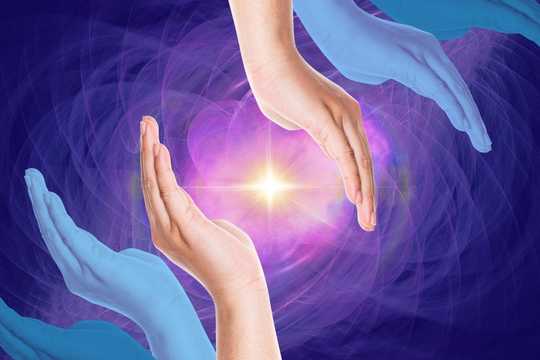This article explores interbeing as a framework for integrating psychedelic experiences. The concept of interbeing comes from Buddhist teacher Thich Nhat Hanh. Join psychologist Tomas Frymann, MA as we explore how the interconnection which psychedelics make visible can offer us healing.
A childhood friend and I sat by a beachside cliff with a dead seal in between us. We were philosophizing about the nature of life. In addition to, mushrooms chimerically coursing through our consciousness. The presence of death was so near, so mammalian, so striking, so perplexing, and so intriguing. Mixing with these divine fungi and a view of the shifting seas, it fueled a sublime and simple epiphany that swept aside my pre-existing notion of self.
“Wave and ocean are in exactly the same relationship as self and universe!” Wave is really just ocean in patterned movement. I am really just universe in patterned movement. Ocean moves and waves arise. Universe moves and peoples arise. Conscious mind n’ all.
The Beatles got it right! “I am he as you are he as you are me, and we are all together.”
After decade later of working with psychedelics, psychology, science, solitude, and sitting (meditation), I’ve recognized that this is perhaps the most fundamental epiphany of value to all contemplative practice. In short, it can be labelled the awareness of Interbeing. We can use Interbeing as a framework for integrating psychedelic experiences.
Interbeing is a critical theme to focus on when preparing for and integrating psychedelic experiences. The reorientation of selfhood accompanying Interbeing awareness is thematic of many psychedelic trips. Meanwhile, it is the basis for much of the potential fear, potential awe, and potential transformation that may occur.
Like an Ocean Wave
“A wave on the ocean has a beginning and an end, a birth and a death. If a wave only sees its form, with its beginning and end, it will be afraid of birth and death. But if the wave sees that it is water, identifies itself with water, then it will be emancipated from birth and death.”
The ocean-wave analogy of selfhood has been used for ages in the Zen tradition. It underscores the notion of Interbeing. Thich Nhat Hanh is the monk who coined the term. He reflected on Interbeing as a framework for integrating psychedelic experiences once.
“A wave on the ocean has a beginning and an end, a birth and a death. If a wave only sees its form, with its beginning and end, it will be afraid of birth and death. But if the wave sees that it is water, identifies itself with water, then it will be emancipated from birth and death.”
To go deeper into the analogy, with both wave and self there is an underlying and all-encompassing context (i.e the ocean / the universe). The context is inseparable from, and in fact is, the entirety of the “individual” (i.e. the wave / the self). Before my mushroom experience on the beach, I had seen myself purely as an individual. I was an embodied consciousness named Tomas, separate from other embodied consciousnesses.
Clearly “point-out-able” as a unitary and defined object. Just like a wave, to which one could point, and say “Look at that wave. Let’s give it a name – John. Saying John this.. John that…” until becoming entirely deluded that there is something, “John”, that is separate from the ocean. Truly, the name John is just a reference to a continuing pattern of motion in the ocean. Likewise, the name “Tom” is just a label for a continuing pattern of motion in the universe – conscious, yet just as fused with its context as the wave is with water.
Illusion of Separation
So back to the story. It took a fraction of a second for the epiphany to hit the depths of my awareness. I felt a space in which my eyebrows could begin to lift. My eyes began to open a little wider. My mouth began to take an “ahhhhh!” shape. As a result, my deep seated confusion and displeasure with death lightened. I previously assumed at least some nebulous but fundamental aspect of myself was separate from the universe. Subtly, and perniciously, that default notion had also led me to:
- See myself as separate from nature.
- See myself as separate from other humans, and finally…
- In that separateness to prioritize myself above nature and other humans.
Consequently, in that dawning moment I felt a merger of my identity with the oceanic, background context that has given rise to all life and consciousness. I noticed that like a wave has no center, similarly a self has no center. And the drop of that self center made me less “self-centered.” At least so long as the awareness lasted… Unfortunately (and also fortunately), the induced state I was in did not last. But, the conditions were set for my life to take a turn for the better. A turn towards living Interbeing.
What is Interbeing?
As formulated by Thich Nhat Hanh, Interbeing describes the connectedness of all conscious being – not just of all material things. It honors that each person is fully unique. The totality of being is ultimately undivided by “separate selves.” The basic structure of reality is not cleaved apart into separate self-timelines. However, it is actually one fully connected conscious process.
As formulated by Thich Nhat Hanh, Interbeing describes the connectedness of all conscious being – not just of all material things.
From this point of view, the ultimate identity of each individual is the universal process itself. This universal process individuates itself into discrete instances of experience. These are uniquely defined by differing from other possible experiences [1]. For example, if you are reading behind a computer in a room, you are not snorkeling with a dolphin or driving a race car. Although those both may sound like good options of things to do.
Endless Possibilities of Unique Experiences
Your unique experience – of body, of memories, of personality, of five senses, etc – exists as it is by differing from other possibilities. And yet, your ultimate identity (the cosmic process itself) is individuating itself not just into you. It’s also individuating into every other conscious being, within the exact same global moment. As that process itself (that underlying identity) in this moment you are ultimately not just you. But every other being as well.
Does Interbeing mean people should be able to remember other people’s experiences? No.
Does it mean your individual self will be reborn as other beings? No.
Does it mean there is a separate higher being that is everyone? No.
Does it mean, as Alan Watts said: “Billions of years ago you were a big bang, and now you’re a complicated human being.” Yes.
And since the most teeny tiny, baby “you” was the “big bang.” Does that mean you, as the big bang in its current continuing form, are ultimately your unique self and yet also everyone else? Yes. And whether or not we call it the big bang, there was some origin. Thus, this origin, in its continued form, is us all. Tying the depth of your identity to this reality is the only scientifically justifiable way to construe who you ultimately are.
Interbeing as a Framework to Integrate Improvements
When you live from a place in which your ultimate identity is increasingly in-step with your heart, you set yourself up for a beautiful, meaningful, and valuable life. In particular, I have noticed 12 benefits arise from this core shift in identity:
- Belongingness
- Purpose
- Fearlessness
- Intimacy
- Awe
- Grounding
- Direction
- Comprehension
- Relaxedness
- Cooperativeness
- Goodness
- Respect
- Belongingness comes from the existential sense of yourself as being in a state of universal kinship with a single family of existence.
- Purpose comes as an upwelling of motivation to use your unique talents in a way that serves that family.
- Fearlessness comes through knowing that while your individual identity will die, your ultimate identity continues.
- Intimacy comes through a mutual goodwill that seeds the conditions for vulnerable connection.
- Awe comes through being in touch with the unimaginable expanse of the cosmos as who you ultimately are.
- Grounding comes from orienting that experiential vastness into a comprehensible framework.
- Direction comes with a greater attunement to the total context of life and needs of others.
- Comprehension comes with realizing that seemingly enigmatic doctrines and wisdoms are actually interpretable in terms of Interbeing.
- Relaxedness comes from relinquishing comparisons and egocentric ambitions in the knowledge that your ultimate identity will have all experiences.
- Cooperativeness comes from a deeply seated goodwill towards “others.”
- Goodness comes from authentic intention to “treat others as yourself” that cycles back around.
- Respect comes along with goodness, when people notice that you have a true intention to do well by others.
Glimpse of Interbeing as a Framework for Integrating Benefits
So does glimpsing Interbeing mean that all these benefits will naturally arise in your life? No. A strong recognition sets the direction on your life compass – to a metaphorical true north. But it does not walk the steps of the path for you. That is where personal choice, committed action, and trusted guidance come into play. Therefore, consider Interbeing as a framework for integrating yourself into a richer existence and life.
References
- Oizumi, M., Albantakis, L., & Tononi, G. (2014). From the phenomenology to the mechanisms of consciousness: integrated information theory 3.0. PLoS Comput Biol, 10(5), e1003588.






